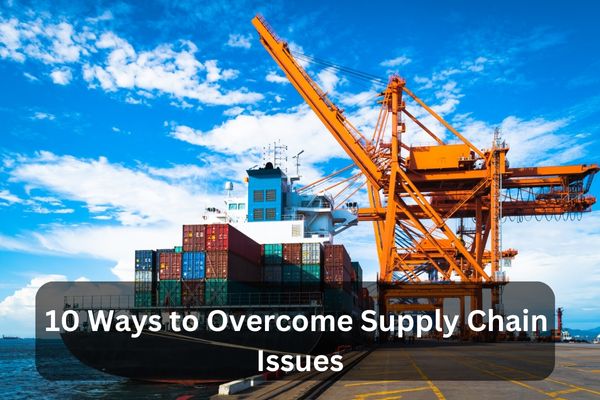10 Ways to Overcome Supply Chain Issues

 Introduction
Introduction- The modern business landscape is marked by intricate networks of suppliers, manufacturers, distributors, and retailers working seamlessly together to meet the ever-changing demands of consumers. This intricate web of connections, known as the supply chain, is the backbone of the global economy. However, despite its significance, supply chains are not impervious to a range of challenges and disruptions that can have far-reaching consequences. These problems can stem from a variety of sources, such as natural disasters, economic fluctuations, political events, and technological changes.In this context, understanding and effectively managing these challenges has become a crucial concern for businesses across industries. From ensuring the timely delivery of products to maintaining cost efficiency and mitigating risks, supply chain problems can impact an organization’s bottom line, customer satisfaction, and overall resilience.
- What Are the Major Supply Chain Challenges?
- Supplier Reliability
- The reliability and consistency of suppliers are paramount to a well-functioning supply chain. Unreliable suppliers can lead to disruptions, production delays, and additional costs. To address this issue, companies often engage in supplier assessments, audits, and collaborate closely with their suppliers to ensure they meet quality standards.
- Demand Fluctuations
- Sudden shifts in consumer demand can disrupt the supply chain. For example, a surge in demand for a product during a pandemic can lead to shortages, while seasonal fluctuations can result in excess inventory. Demand forecasting and flexible production capabilities are essential to manage this challenge.
- Logistics Disruptions
- Transportation and shipping problems can include delays due to weather, labor strikes, or capacity constraints. Rising fuel costs and changing trade routes can also impact logistics. Companies often work with logistics partners and maintain contingency plans to address these disruptions.
- Inventory Management
- Poor inventory management can result in carrying too much or too little stock. Excess inventory ties up capital, while shortages can lead to missed sales opportunities. Companies use inventory optimization software and just-in-time (JIT) inventory strategies to address this challenge.
- Global Events
- Events like natural disasters, political instability, or public health crises (e.g., the COVID-19 pandemic) can severely disrupt supply chains. Companies need robust risk assessment and business continuity plans to respond effectively to these events.
- Cybersecurity
- As supply chains become more digitized, the risk of cyberattacks on critical systems and data has increased. Data breaches can compromise the integrity of supply chain data and operations. Companies invest in cybersecurity measures and data protection to mitigate this risk.
- Regulatory Compliance
- Changing regulations and trade policies can impact the movement of goods across borders. Companies must stay informed about regulatory changes and adapt their supply chain strategies and compliance procedures accordingly.
- Supplier Diversity
- Relying on a limited number of suppliers makes the supply chain vulnerable to disruptions if one supplier encounters problems. Diversifying the supplier base can help mitigate this risk.
- Environmental Concerns
- Sustainable practices and environmental regulations are becoming increasingly important in supply chain operations. Companies must align their practices with these concerns to meet customer expectations and regulatory requirements.
- Technology Adoption
- Failing to adopt or adapt to new technologies can lead to inefficiencies in the supply chain. Technologies like blockchain, IoT, and AI can enhance visibility, automation, and decision-making in the supply chain.
- How to Overcome Supply Chain Issues?
- Supplier Diversification
- Relying on a single supplier can make your supply chain vulnerable to disruptions if that supplier encounters problems. By diversifying your supplier base, you spread the risk. This approach allows you to source critical materials or products from multiple suppliers, ensuring a backup plan if one source experiences problems.
- Enhanced Visibility
- Visibility into your supply chain is crucial for effective management. Modern supply chain visibility tools and technologies provide real-time insights into inventory levels, shipments, and potential disruptions. This visibility enables you to make informed decisions, adjust inventory, and proactively address problems as they arise.
- Safety Stock
- Safety stock is a buffer of extra inventory held to meet unexpected demand or supply disruptions. It’s particularly useful for critical items that can’t afford to run out. Maintaining safety stock helps ensure business continuity when supply chain hiccups occur, bridging the gap until your regular supply chain is restored.
- Risk Assessment and Mitigation
- To effectively manage supply chain disruption in automotive industry you need to identify and prioritize potential risks. This involves conducting thorough risk assessments, determining which problems pose the greatest threats, and developing strategies to mitigate those risks. A well-thought-out mitigation plan helps you respond to disruptions more effectively.
- Supplier Collaboration
- Strong relationships with your suppliers are essential. Collaborate with your suppliers to share information, develop demand plans, and jointly address risk management strategies. This proactive approach can lead to better communication and problem-solving when issues arise.
- Just-in-Time (JIT) Practices
- JIT is an inventory management method that aims to minimize carrying costs by receiving goods only as they are needed in the production process. However, for critical items, consider a balanced approach that combines JIT with safety stock to mitigate the risk of running out of essential materials.
- Technology Adoption
- Embracing technology is vital for supply chain optimization. Technologies like blockchain, the Internet of Things (IoT), and artificial intelligence (AI) offer real-time tracking, monitoring, and automation capabilities. These tools enhance visibility, automate tasks, and facilitate data-driven decision-making.
- Geographic Diversification
- Concentrating your suppliers or manufacturing facilities in one geographic region can make your supply chain susceptible to regional disruptions. Geographic diversification involves spreading your supplier and production base across different regions or countries, reducing the risk of disruptions affecting all locations simultaneously.
- Crisis Response Plan
- Preparation is key to effective crisis management. Develop a comprehensive crisis response plan that outlines how your organization will react to different types of disruptions, from natural disasters to economic crises. Ensure that all stakeholders are familiar with the plan and conduct drills or simulations to ensure a swift and effective response.
- Data Analytics
- Data analytics and predictive modeling can help forecast potential disruptions, demand fluctuations, and inventory requirements. By analyzing historical data and market trends, you can make informed decisions and anticipate problems. Data-driven insights enable you to proactively manage your supply chain and respond to challenges more effectively.
- In Conclusion, addressing and overcoming supply chain problems is essential for the success and resilience of modern businesses. The 10 strategies outlined provide a comprehensive framework to tackle these challenges effectively. By implementing these approaches, organizations can navigate disruptions, mitigate risks, and ensure the smooth flow of goods and services.By embracing these strategies and drawing from the collective wisdom of industries that have faced supply chain disruptions, organizations can not only address immediate problems but also future-proof their supply chains for an increasingly dynamic and interconnected global marketplace.








